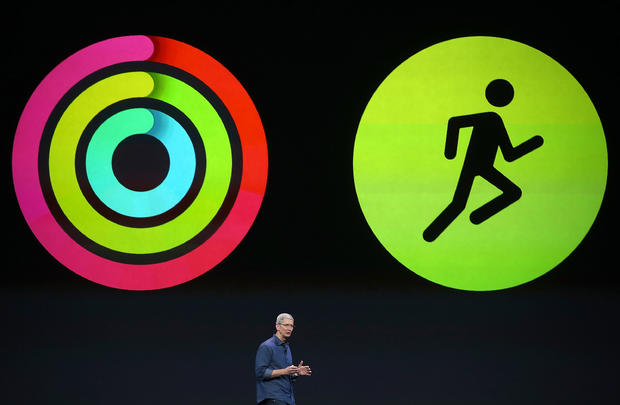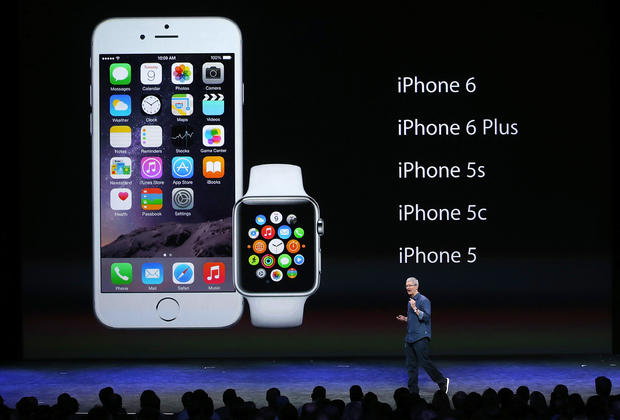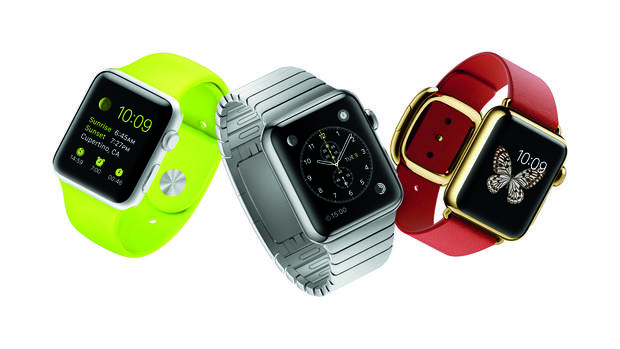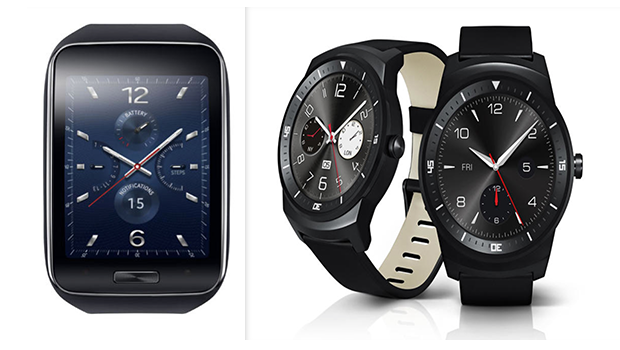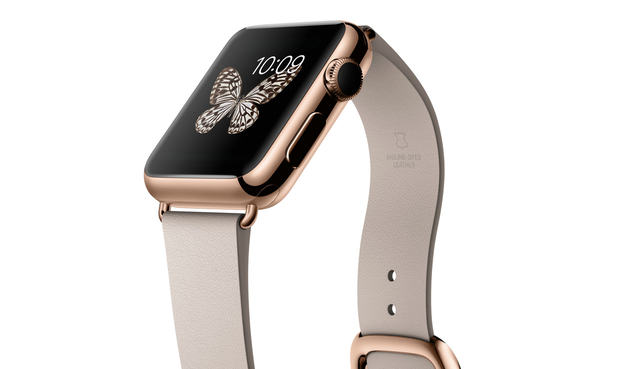Apple Watch coming this April: What you need to know about Apple's first smartwatch
Apple is about to enter the world of wearables this April, with its first new product category since the iPad in 2010.
Officially unveiled at Apple's fall 2014 media event in Cupertino, Calif. alongside the iPhone 6 and 6 Plus, the Apple Watch may well have been one of the most anticipated products of recent years. It's made its presence known for months, and a software development kit has been released so that developers can create Apple Watch apps in advance of the product launch.
It's a smartwatch, another entry into a landscape that's suddenly exploded. Will it be the savior of smartwatches, or just another charmingly flawed wrist-gadget? We don't know the answer yet. The Apple Watch doesn't have an "i" in its name, and it isn't an iPod, but it's already clear that the Apple Watch has become a major tentpole that the rest of the wearable industry is adjusting to accommodate. Here's what we know so far as we head towards its expected April release.
Click through for all the details.
The basics
What does it cost?
We know the Apple Watch will start at $349 in the US for the aluminum and glass Apple Watch Sport, with prices elsewhere yet to be announced (a rough conversion would be £220 or AU$380). We don't know what higher-end tiers of the watch will cost, or what accessories will be priced at. The stainless-steel Apple Watch with its sapphire crystal-covered display, is bound to cost at least significantly more, while the 18-karat-gold Apple Watch Edition could climb to price levels associated with fine jewelry.
What does it do?
The Apple Watch is a music player like an iPod; a fitness tracker with heart-rate measurements; a communications device that will send and receive messages, calls and audio recordings; and a handheld portal to other apps, too. It also makes payments via Apple Pay. It can also control your Apple TV and act as a remote for connected smart-home devices.
The Apple Watch seems intent on being a synthesis of many other smartwatches, trying to knit together all of these features into a coherent whole. In some ways, the Apple Watch's notifications, voice-activated controls, and swipe-to-glance features feel like elements of Google's Android Wear watches. And the focus on apps and built-in features like voice calling seem like what the Samsung's Tizen OS-based Gear watches have tried to aim for in the past.
But if you want the basic breakdown, in case you haven't used a smartwatch before: it keeps you connected to your phone, acts like a mini iPod, works as a fitness tracker, and could even replace your wallet. And it could do a lot more, too. Apple has shown how the device could not just make mobile payments, but also act as a digital key to open a smart lock on a front door at home. Apps will also allow you to access other home-automation features, such as smart thermostats, using your iPhone's wireless connection as a conduit.
And hey, it also tells the time; Apple actually claims high-precision accuracy within 50 milliseconds, and a variety of high-design customizable watch faces will do everything from show lunar cycles and weather to give quick-glance messages and calendar appointments.
Watching your waistline
Apple Watch and fitness
Fitness will be a big part of the Apple Watch, and while a number of third-party apps should be available by launch, Apple has two of its own fitness apps. One tracks everyday activity via a trio of three metrics: estimated caloric burn, moderate exercise, and time spent standing; while another tracks dedicated workouts, including activities like cycling. Each syncs back to a hub app on the iPhone.
Four sapphire lenses on the back of the Apple Watch measure heart rate using a combination of infrared and LED technology, promising to deliver more accurate results than other wrist-worn optical heart-rate monitors. But, it seems, Apple's heart-rate tech activates only during workouts, as opposed to the 24-hour tracking of devices like the Microsoft Band, Basis Peak and Fitbit Charge HR/Surge. The measurement of everyday "non-workout" exercise is determined by pinging GPS on the iPhone and using accelerometer data, while the "time spent standing" measurement rewards you for standing one minute each hour, like Nike's FuelBand.
The Apple Watch works with other fitness apps -- it's Nike Plus-supported, and there are bound to be more apps by the time it launches.
The nitty gritty
Which phone do you need?
To pair with an Apple Watch, you'll need an iPhone 5, 5C, 5C, 6 or a 6 Plus. Sadly, earlier iPhones are excluded. So are other phone platforms like Android. This is an iPhone-owner's product, much like Samsung's Gear watches run only on certain Samsung phones, or Android Wear watches require Android phones.
How it seems to work
Like most smartwatches, the Apple Watch is designed to be an adjunct to your iPhone. It's meant to stay paired and connected while you wear it for most features, but it also does some things while disconnected, too.
The Apple Watch has a small, bright color touch display plus a scroll-wheel digital crown and button on the side for extra features. You can touch and swipe to interact, or speak to its microphone.
The watch runs on a brand-new S1 processor, is equipped with a gyro and accelerometer, and can piggyback on the Wi-Fi and GPS from your phone. You press down on the crown to get to the home screen. The watch will take dictation and offers very precise synchronized time to plus or minus 50 milliseconds. It also has a "Taptic" haptic processor that offers a subtle vibrational feedback for notifications, alarms and other messages, plus a force-sensitive touch display.
Like the iPhone 6, the Apple Watch has NFC. This will enable those Apple Pay payments and help it act as a door-opening key at hotels.
How does it charge? Via a clever combination of magnets and inductive charging: the charger just snaps on the back.
The look and feel
How many styles does it come in?
A lot, but they're all based on the same curved-edge rectangular-screen design. There are three different construction styles, two different sizes and six different watch bands, leading to a surprising number of combinations. The first variant, Apple Watch, has a stainless steel case, a ceramic back and a sapphire crystal. The Apple Watch Sport has an aluminum body, composite back and Ion-X glass screen. The Apple Watch Edition has a ceramic back and sapphire crystal, but also adds 18-karat gold to its body.
There are larger and smaller sizes, called "42mm" and "38mm," which amount to men's and women's sizes -- or adult and kid. The bands span a variety of designs: a Milanese loop of metal mesh with magnets, a leather band that auto-attaches, a segmented metal band, a classic leather watch band, and a more plasticized sport band in bright colors. They span the gamut, and you can bet there will be tons more from other manufacturers. They detach easily, too, for band-swapping.
What did it feel like on my wrist?
Good -- and comfortable. While the Apple Watch may seem a lot like other square-screened smartwatches, its fit and finish are refined. Its design is a bit like a mini-iPhone, but also reminiscent of the 2011 iPod Nano, yet curved. I tried on a stainless steel Apple Watch with metal link band, an Apple Watch Sport with a rubbery sport band, and a smaller Apple Watch with a leather band. They all had a great wrist feel.
The Apple Watch doesn't have a round display like some Android Wear watches, but its build quality seemed even better than the Moto 360 and LG G Watch R. It shares some similar design elements to recent smartwatches like the Asus ZenWatch and Samsung Gear S. Even if the watch body itself doesn't always seem striking, the Apple Watch does seem to morph depending on its accessories.
The screen on the 42mm model is about the size of a Pebble Steel, and felt more discreet than some larger Android Wear and Samsung Gear watches. The smaller 38mm watch felt too small for me, but it looked pretty good on smaller wrists showing it off.
The watch I tried on just ran a set demo loop, much like early Android Wear watches at Google I/O. For deeper features, you had to see one on an Apple employee's wrist. But even on the loop, you could feel Apple's "Taptic" engine. It's much like vibrations on other watches like those from Android Wear and Pebble, but this one feels capable of a more subtle range of vibration styles.
The watch isn't surprising in design, but it's elegantly made. The bands in particular feel well thought out: a steel mesh one has magnets that wrap and attach, and so does a cool segmented leather one. And the snap-on magnetic inductive charger is great: it avoids weird snap-on dongles, but also means the watch won't detach from the charger when in a bag or an airline seat pocket.
The field
How is it different from other smartwatches?
The Apple Watch has some newer technologies that other smartwatches, to date, haven't adopted.
Apple's watch is the one of the first mainstream wearables to support mobile payments: Apple Pay will be enabled via NFC, meaning you can swipe to pay at stores, and possibly pay for things online, too -- and open doors at hotels, among other things.
The Apple Watch uses haptic feedback, but it also has a force-sensitive display: press harder, and it will do different things. This could mean more advanced types of notification buttons, or control input.
Apple also added a different type of input: a little Digital Crown on the side is a clever idea, merging a home button and scroll wheel in one. It aims to help make pinch-to-zoom and scroll functions easier to pull off, while IR and photo sensors give it extra sensitivity. That, and a button below that brings up favorite friends and contacts, offer a set of buttons that don't require the screen at all. You still can swipe and tap, too.
The heart-rate tracking technology could also be a little different. It works optically, much like recent heart-rate wrist monitors, but the four-sapphire-lens array underneath seems a lot more robust, at least in external design. We don't know how it performs yet.
Apple's watch will run its own distinct app platform. Android Wear already has a fair amount of app support, but apps are a secondary part of Google's watches. The Apple Watch puts its apps in the spotlight on the main display. Apple released its WatchKit API last year, counting on courting developers to make the watch do lots of things by the time it goes on sale. That could help Apple catch up to existing platforms like Android Wear.
Using a direct-communication suite of apps called Digital Touch, the Apple Watch will also act as a personal communicator to other Apple Watch owners: you can scribble little emoji, send vibration-enhanced love taps, or send audio messages like a walkie-talkie. High-school classrooms, look out.
What's its main competition?
Samsung and its expansive collection of Tizen-based smartwatches, and the ever-improving world of Android Wear Google-driven smartwatches are the places where Apple Watch faces the stiffest competition, but there will be lots of smaller, high-fashion smartwatches emerging to compete, too. Pebble is planning new products, Swatch has its own smartwatch in the works, and there are sure to be others. Apple's watch may precipitate a lot of mainstream fashion-tech competition in the coming months. If you consider the Apple Watch as a fitness gadget, then all-day heart-rate trackers like the Basis Peak, Microsoft Band, and Fitbit's latest wearables could be seen as potential alternatives.
Good questions
What can it do when it isn't connected to a phone?
The Apple Watch is meant to be connected to an iPhone, but it also does some things stand-alone based on what we know so far: track activity and fitness, make payments using Apple Pay, and play music that's been downloaded to the watch. However, even some elements of fitness tracking seem dependent on phone-paired functions, like GPS. Yes, the Apple Watch will sync playlists, although how much dedicated storage it'll have isn't known. Basically, we don't know yet how good Apple Watch will be as a stand-alone device, but it will function.
Can left-handed people use it?
Sure, the digital crown is on the right side of the Apple Watch, but don't worry: You'll be able to put it on either wrist. The Apple Watch design is reversible, and and you can set which way the screen flips, so the crown can be on the other side: the only change would be that the bottom button for contacts would end up on the top.
What's its battery life like?
Don't expect much. Tim Cook has said to expect to charge the Apple Watch once a day, and recent reports suggest a one- or two-day battery life, similar to what early Android Wear watches had. It all depends on how much active use the Apple Watch can get versus stand-by time, and how often the Apple Watch pings the iPhone. From all indications, battery life doesn't sound great.
And the bottom line...
Who needs it?
When the iPad first debuted, many demeaned it as either a "big iPhone" or a keyboardless laptop, but it managed to stake out its own ground. The Apple Watch will enter the same skeptical marketplace, with an even harder case to make: if it's essentially a dedicated smartphone accessory, is it just a redundant gadget? A lot of people might wonder why they need it. Can the Apple Watch carve out some killer features that make sense to people? Or, is it mainly a fashion accessory with tech appeal?
For fitness-lovers who want a smart connected workout device that plays music, the Apple Watch could be a slam dunk if done properly, especially since the fitness-wearable landscape is still in flux with few fantastic products. But Apple will need to prove how good its watch can be at what it does, much like what the iPad ended up doing for a lot of people.
We will still don't know how good it is as a fitness device. And, even though everything from car apps to home apps to door-opening hotel apps have already been demonstrated or teased, the specific types of apps it will run, and the connected infrastructure needed to make those apps work, are still largely unknown. Apps will be a big part of what makes the Apple Watch succeed or fail.
If Apple nails these parts and feels easy to use, then Apple Watch could be the "it just works" device of wearable tech. We'll know soon enough.
Stay tuned for April.
Editors' note: This article was originally published on Sept. 11, 2014, and has been updated periodically since then as more information becomes available.


